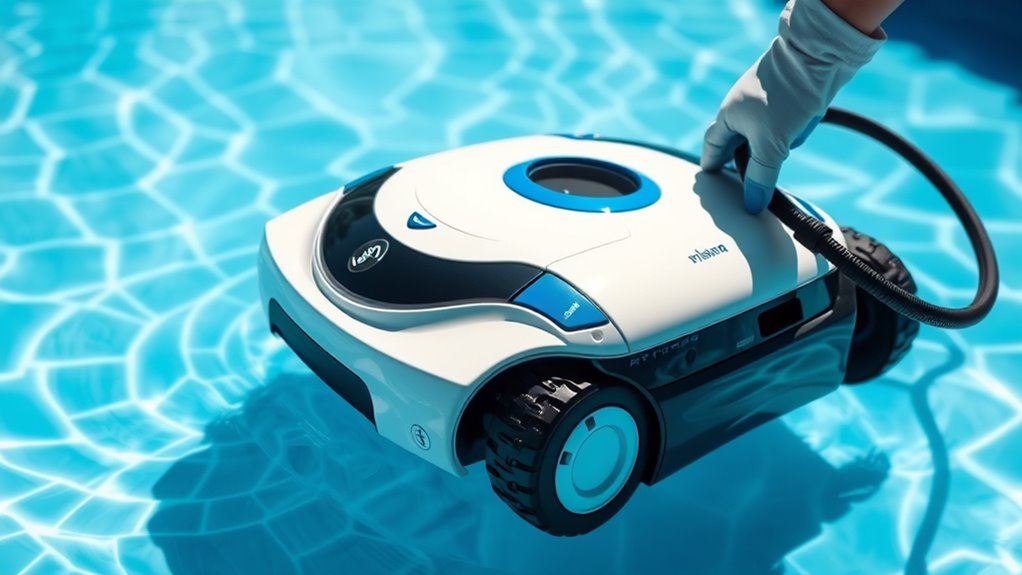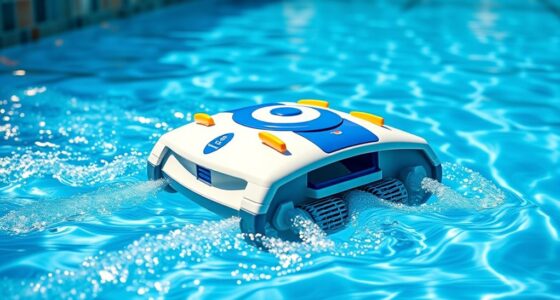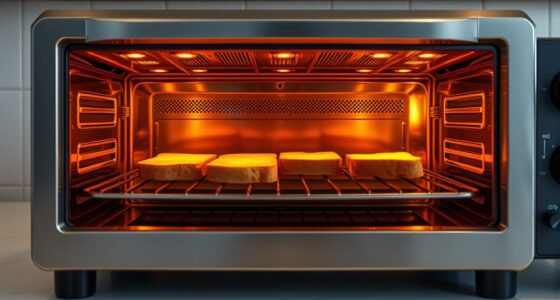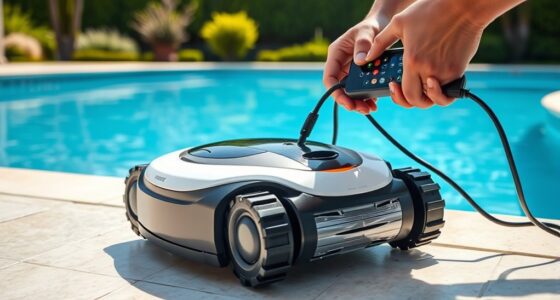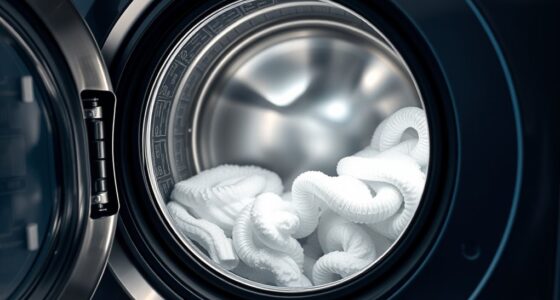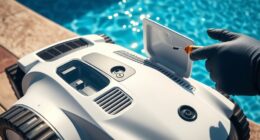To guarantee your robotic pool cleaner lasts, regularly clean and replace the filters, check and swap out worn brushes, and inspect other components like wheels and sensors for obstructions. Proper maintenance keeps the device running efficiently and prevents costly repairs. Following these simple steps and sticking to the manufacturer’s guidelines can extend its lifespan. Want more tips on keeping your cleaner in top shape? Keep going to learn all the essential care strategies.
Key Takeaways
- Regularly clean and rinse filters to maintain suction power and prevent debris buildup.
- Inspect and replace worn brushes every few months to ensure effective scrubbing.
- Check wheels, sensors, and suction pathways for obstructions and clean as needed.
- Follow manufacturer guidelines for scheduled component replacements and routine maintenance.
- Dedicate a few minutes after each use for overall inspection to prevent costly repairs.
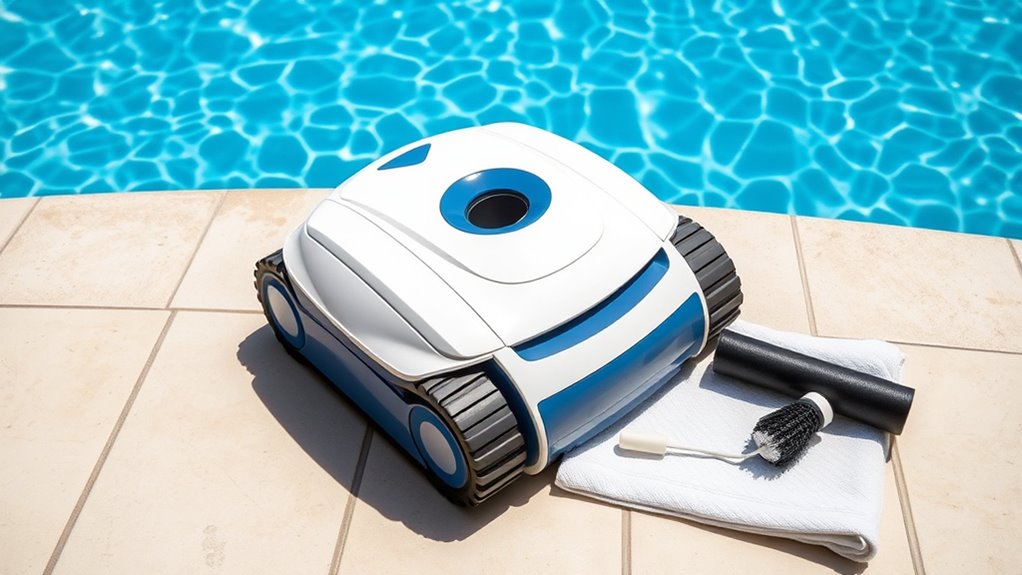
Keeping your robotic pool cleaner in top condition guarantees it works efficiently and lasts longer. One of the most important aspects of maintenance involves regularly checking and cleaning the filter. Over time, debris such as leaves, dirt, and algae accumulate in the filter, reducing your cleaner’s ability to pick up debris effectively. To keep it functioning at peak performance, you should remove the filter after each pool cleaning session and rinse it thoroughly with a hose. If the filter appears clogged or worn out, replace it promptly. A clean filter ensures maximum suction power, helps prevent motor strain, and extends the lifespan of your device. Regular filter maintenance can also prevent the buildup of bacteria and mold, which can affect your pool’s water quality. Neglecting filter maintenance can lead to decreased efficiency, more frequent breakdowns, and ultimately, costly repairs or replacements. Regularly inspecting your robotic cleaner’s components can also help identify potential issues early before they become costly problems. Additionally, consulting your manufacturer’s guidelines for component replacement can ensure you’re maintaining your device according to the recommended schedule. Incorporating preventive care strategies can further enhance the longevity of your robotic pool cleaner. Proper routine inspections are a key part of effective maintenance, helping you catch problems early. Another critical maintenance task is brush replacement. The brushes on your robotic cleaner are responsible for scrubbing the pool floor and walls, dislodging stubborn dirt and algae. Over time, these brushes wear down, become brittle, or lose their bristles, which diminishes their cleaning effectiveness. Regularly inspecting the brushes is essential; if they look frayed, cracked, or substantially worn, it’s time to replace them. Most manufacturers recommend replacing brushes every few months, depending on usage and pool conditions. Installing new brushes is usually straightforward—just snap or unscrew the old ones and attach the new ones securely. Doing so ensures your cleaner maintains ideal scrubbing power, leading to a cleaner pool with less effort. Plus, fresh brushes reduce the strain on the motor, which can prevent unnecessary wear and tear. Proper brush maintenance also helps keep your device operating smoothly and prevents unnecessary mechanical issues. In addition to filter maintenance and brush replacement, it’s wise to periodically check the cleaner’s wheels, sensors, and suction pathways. Keeping these parts clean and free of obstructions helps avoid operational issues and prolongs your device’s lifespan. Remember, consistent maintenance doesn’t just improve performance; it also saves you money in the long run. By dedicating a few minutes after each cleaning session to inspect and clean filters and replace brushes as needed, you’ll keep your robotic pool cleaner running smoothly season after season. Maintenance might seem like a chore, but it’s a small effort that yields notable benefits—more efficient cleaning, fewer repairs, and a longer-lasting device. Your investment in regular upkeep pays off by ensuring your robotic cleaner remains a reliable tool for a sparkling, inviting pool all summer long. Proper water park maintenance and care practices can also extend the lifespan of your equipment.
Frequently Asked Questions
How Often Should I Replace the Brushes on My Robotic Pool Cleaner?
You might wonder how often to replace the brushes on your robotic pool cleaner. For thorough brush maintenance, check them regularly for wear and tear. Generally, a good replacement schedule is every 3 to 6 months, depending on usage and water conditions. Keep an eye out for frayed or worn brushes, and replace them promptly to guarantee your cleaner works efficiently and lasts longer.
Can I Leave My Robotic Cleaner in the Pool Overnight?
Think of your robotic pool cleaner as a diligent swimmer—should you leave it in overnight? For pool safety, it’s best to remove it to prevent accidents, especially if kids or pets are around. Additionally, leaving it in can increase energy consumption unnecessarily. By taking it out after cleaning, you protect your pool’s safety, save energy, and extend your device’s lifespan, ensuring it’s ready for its next splash-filled adventure.
What Is the Best Way to Store My Robotic Pool Cleaner During Winter?
During winter storage, you want to keep your robotic pool cleaner in top shape. First, clean it thoroughly and remove any debris. Then, store it indoors or in a dry, sheltered outdoor space. Make certain you protect it from harsh weather with a waterproof cover or outdoor protection. This prevents damage from cold temperatures and moisture, helping your cleaner stay ready for the next swim season.
How Do I Troubleshoot if My Cleaner Is Not Charging Properly?
If your robotic pool cleaner isn’t charging properly, start by checking for charging issues. Confirm the power source and cord are secure and undamaged. Clean the charging contacts on both the cleaner and the dock, as dirt or debris can hinder battery troubleshooting. If it still doesn’t charge, try resetting the device or replacing the battery if possible. Regularly inspecting these components helps prevent charging problems and keeps your cleaner running smoothly.
Are There Specific Pool Chemicals That Can Damage My Robotic Cleaner?
You might wonder if certain pool chemicals could harm your robotic cleaner, and the answer is yes. Some chemicals, like harsh chlorine levels or algaecides, can cause robotic cleaner corrosion over time. Always check your cleaner’s manual for pool chemical compatibility, and avoid mixing chemicals directly near your device. By doing so, you’ll safeguard your robotic cleaner from damage and ensure it keeps working smoothly season after season.
Conclusion
To keep your robotic pool cleaner running smoothly, you need to clean it regularly, inspect it carefully, and store it properly. You need to remove debris after each use, check for wear and tear, and store it in a dry, shaded place. You need to follow the manufacturer’s instructions, perform routine maintenance, and stay attentive to signs of trouble. By doing these things, you guarantee longevity, optimize performance, and enjoy a crystal-clear pool all season long.
